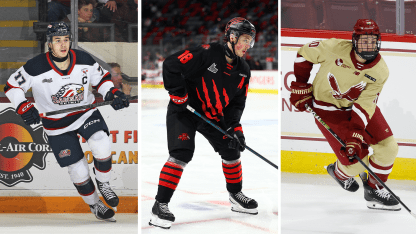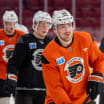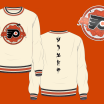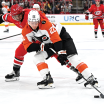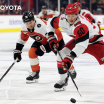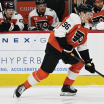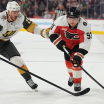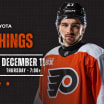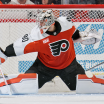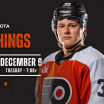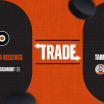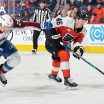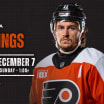The 2025 NHL Entry Draft is loaded with first-round candidates who exclusively play center or are center/wing swingmen who primarily center their line at their current level of competition. That works in the Flyers' favor.
The Flyers' drafting philosophy in the first round is to go strictly by their internal rankings of best available players regardless of position. Later in the Draft, they may opt for increased depth at a certain position. The 2025 NHL Draft is one where positional needs and the internal rankings may overlap.
"We are aware of our organizational needs. But, in the first round, we won't pick centers just to pick centers. It's going to be the available player who is highest on our list. Yes, if it's a tossup between two similar players and one is a center, that can sway it. But we're not going to pass on someone we like better if he's a wing or a defenseman," Flyers assistant general manager Brent Flahr said.
Here's a list of seven centers the Flyers may consider if available with the sixth overall selection. There is also a list of three centers who may come into play if the Flyers trade up with their second (22nd overall) and/or third (31st overall) picks of the first round.
Note: Swingmen who currently play more wing than center, such as Carter Bear, will be noted in an upcoming article on wing candidates for the 2025 first round.
Early first-round candidates
Michael Misa (Saginaw Spirit, OHL): An offensive dynamo in the Ontario Hockey League. The Flyers may need to trade up into the top four (possibly the top two) to select Misa. Surprises happen at the Draft. However, the chances of the Flyers moving up from sixth are relatively small. Some pundits feel that Misa may ultimately play wing as a pro. It's a bit more forgiving on the defensive awareness side. However, Misa presently is an exclusive center.
Caleb Desnoyers (Moncton WIldcats, QMJHL): The younger brother of Phantoms' center/wing Elliot Desnoyers is a very well-rounded prospect. He may not have superstar offensive upside but it's well above average. He's also very reliable defensively. At present, Desnoyers may not be available beyond the top five of the first round. However, he played through injuries to both wrists during the 2024-25 season and did not participate in physical testing at the NHL Scouting Combine.
Anton Frondell (Djurgarden, Allsvenskan): One of the best pure shooting centers in this year's Draft. He also has two-way upside. There are some concerns that he underachieved for Team Sweden in the Under-18 World Championship. There are also consistency quibbles. Overall, though, Frondell is a potential top-five candidate. He may eventually see time at both center and wing at the NHL level.
James Hagens (Boston College, NCAA): Hagens has been on the scouting radar for years. He entered the 2024-25 season as the consensus favorite to become the first overall pick of the 2025 Draft. His freshman performance at BC didn't meet the hype. As such, many pundits predict the player will land in the top-five to top-10 range. He's on the smaller side of "average-sized". However, in terms of sheer offensive skill and creativity, Hagen's ceiling is still very high.
Brady Martin (Soo Greyhounds, OHL): Martin's stock rose with a bullet over the second half of the 2024-25 season. He went from flying under the radar (mid-to-late first-round projections) to probable top-four to top-10 candidate. He had a tremendous U18 tournament for gold medalist Canada. Martin plays a very gritty and physically involved style of hockey and gets ice time in all situations. He's considered a potential future NHL captain or alternate captain. Stylistic comparisons: Mike Richards, Bo Horvat, Scott Laughton. Offensive upside projections vary. Martin can play center or wing, and could be someone who plays up and down in a 5-on-5 lineup rotation in the NHL.
Jake O'Brien (Brantford Bulldogs, OHL): Arguably the best pure playmaker in the Draft crop along with Hagens, O'Brien is also considered to be near the top of the class in hockey sense. Born June 16, 2027, O'Brien is on the younger end of this Draft class. He didn't turn 18 until very recently. O'Brien missed the U18s due to injury but he is fine now. Presently, he is tall and skinny (6-foot-2, 172 pounds) and it will probably take him a few years to fill out. Eventually, he aims to play in the 190-to-195 pound range. Added strength would also help him develop more explosive skating.
Roger McQueen (Brandon Wheat Kings, WHL): The player's allure is all about the tools -- 6-foot-5, naturally skilled and athletic, physically competitive. The concerns: 1) McQueen is coming off a back injury that limited him to 17 games played (20 points) during the 2024-25 season; 2) He's shown hints of dominance at the junior level but they are flashes, not sustained elite play; 3) born October 2, 2006, McQueen lost a year of development this year and is nearly a year older than some of the youngest players in this Draft class. However, reports on the back injury are positive. McQueen returned to play three playoff matches and got a clean bill of health from doctors.
Mid-to-late first round projections
Cole Reschny (Victoria Royals, WHL): A high-skill and smart all-around forward, the playmaking Reschny flies under the radar in public discourse. He flirted with a point-per-game in the Western League in 2023-24 and exploded for 92 regular season points (26 goals,66 assists) in the 2024-25 regular season. He added 25 points (nine goals, 16 assists) in just 11 playoff games. Why isn't he a consensus top-10 candidate? He's an average skater of average to slightly-below average size for an "ideal" center.
Ben Kindel (Calgary Hitmen, WHL): The undersized (5-foot-10, 175 pound center) often draws stylistic comparisons to Montreal Canadiens standout Nick Suzuki. Another scout described him as "Morgan Frost with a little more jam and a little less dangle". Kindel posted 99 regular season points in Calgary this year plus 15 playoff points in 11 games. He has a deceptive shot that he uses when opponents overplay the pass.
Braeden Cootes (Seattle Thunderbirds, WHL): Team Canada's captain on the U18 gold medal squad is considered a high-floor, moderate ceiling player. One of the smartest checking forwards in the Draft (along with Desnoyers and Frondell), he wins a lot of battles. He has skill and a knack for timely offense but the point production to date hasn't been anything eye-popping. The general consensus is that he's a safe bet to become a strong third-line center and could surprise by developing into an upper-tier middle-six (AKA viable second-liner) contributor.

